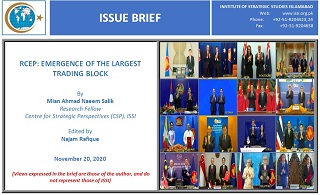In yet another blow to the Trans-Pacific Partnership after the US withdrawal in 2017, the Association of Southeast Asian Nations (ASEAN) have signed an agreement on November 15, 2020 to form a Regional Comprehensive Economic Partnership (RCEP). The new partnership includes the ten ASEAN nations and five of their major trading partners Australia, China, Japan, New Zealand, and South Korea. The 15 member countries account for about 30% of the world’s population and 30% of global GDP, making it the world’s biggest trade bloc.[1] RCEP, an extension of China’s increasing influence in Asia-Pacific, is being viewed as a counter to US strategic pivot to Asia.
RCEP was signed at the Vietnam-hosted virtual ASEAN Summit and is expected to take effect within two years, after it has been ratified by the member countries.[2] The trade pact, which includes a mix of high-income, middle-income, and low-income countries, was conceived at the 2011 ASEAN Summit in Bali, Indonesia. India pulled out of the agreement in 2019 over concerns about cheap Chinese goods entering the country and was a notable absentee during the virtual signing. It can join at a later date if it chooses.[3]















